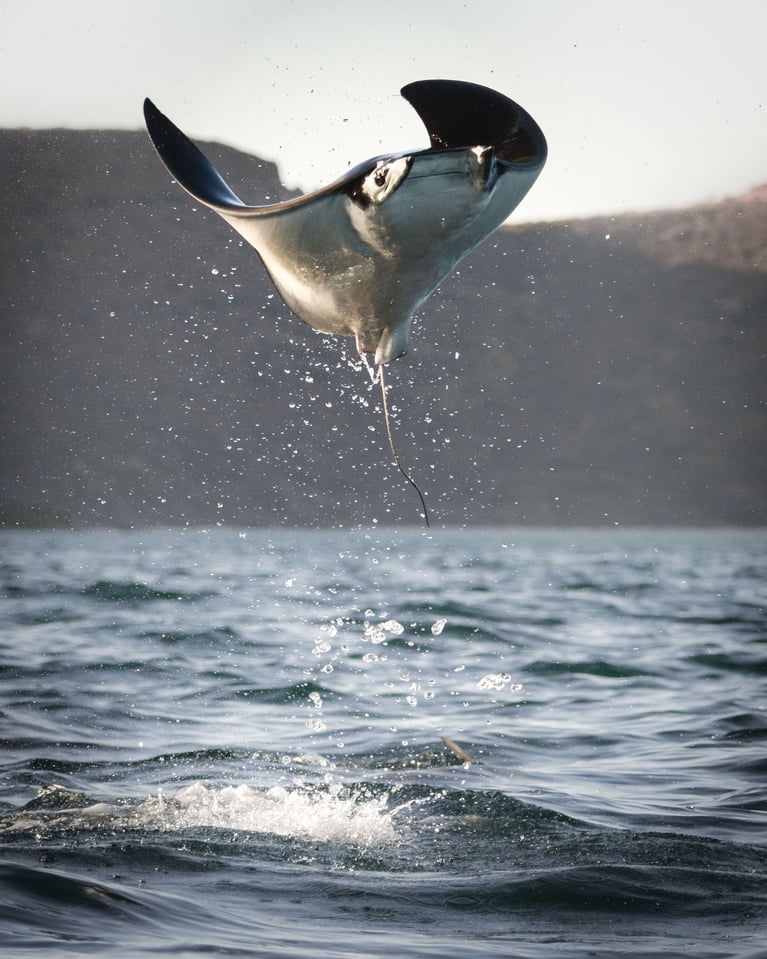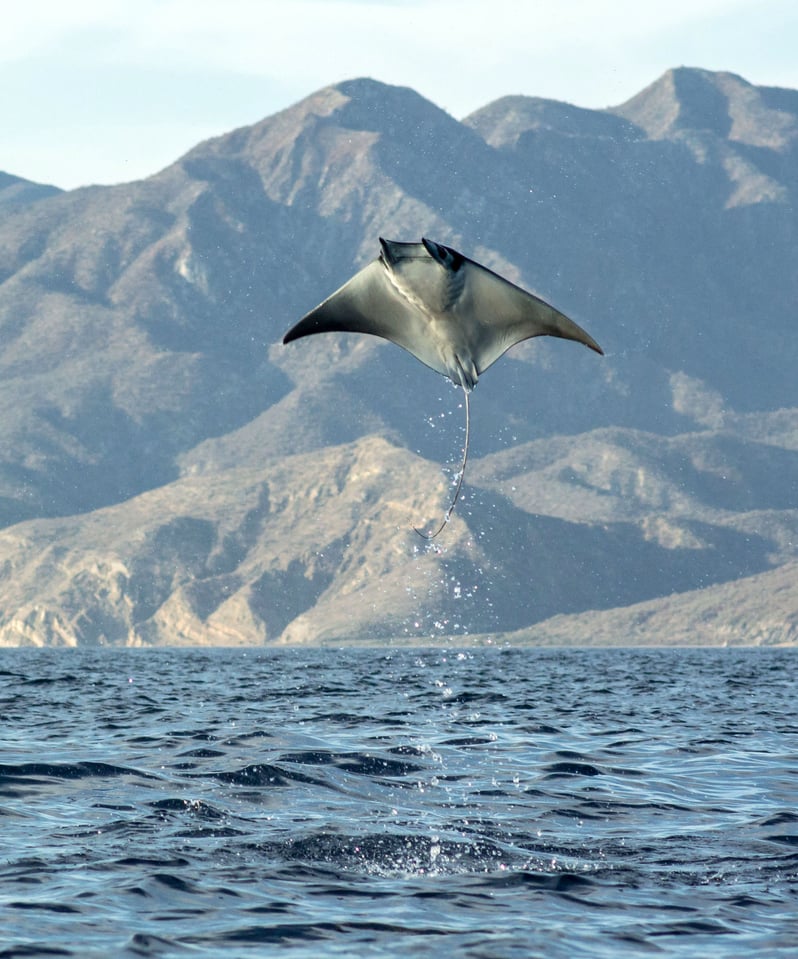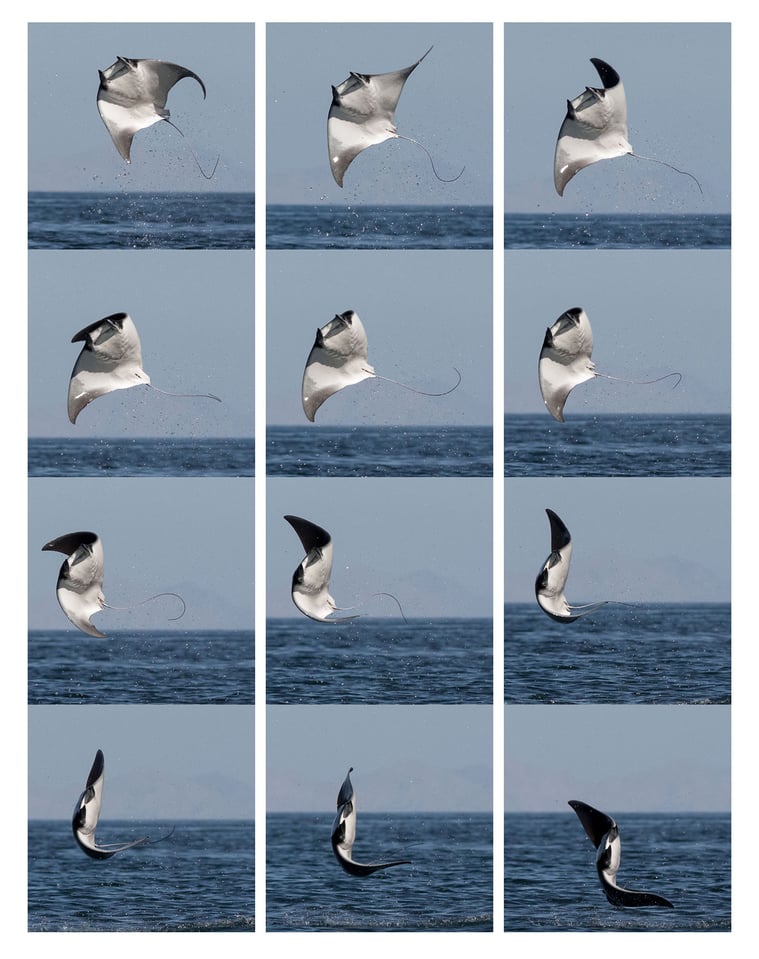The sea of Cortes, in Baja California, Mexico, is known for its amazing marine wildlife spectacles, but among all those, one, in particular, is awe-inspiring. Every year, thousands and thousands of devil rays enter this sea in schools so large that the sea becomes black. In this article, I will talk about my experience taking pictures and video of jumping devil rays.
Devil rays are the manta ray cousins. Extremely similar in shape and behavior, only smaller and prone to congregate in large groups.
They also exhibit an interesting behavior: without warning, they will start jumping 6 feet out of the water.

Their leaps start elegantly; in an aero/hydrodynamic tour de force, their bodies cut clean the water surface and jump 6 feet towards the sky. Landing, however, is a different story. After gravity takes over, they often meet the water with a painful, noisy, belly splash.

This is the reason some people speculate that they jump to dislodge parasites, or to compete for the loudest splash in order to find a mate or communicate. Or perhaps they do it just because it is plain pure fun. And because they can.
What everyone agrees however, is that this is one of the most thrilling wildlife spectacles in Baja. And trying to photograph them is a lot of fun. It can be frustrating too, because the jumps appear completely unpredictable.
The first time I witnessed the spectacle in 2011, I was carrying the Nikon D90, and the 18-200 super zoom lens. I managed to capture one semi decent shot:

Now, in order to get an idea of what it took to get this shot, go to your kitchen, make some popcorn, and try to photograph the kernels as they pop out of the pan. Ah! I forgot, you must shoot it from your bathtub, floating on an inflatable duckie, while your significant other makes waves back and forth.
That’s right. I travel by kayak, so the shots are captured from a floating, moving platform. Forget about using a tripod then.
Kayaks are great, because:
- They are silent, I can hear the jumps from very far away, and find the mobulas.
- Mobulas do not get scared by them.
- I can get to places where boats can’t.
- The pictures of the mobulas look way cooler from surface-level than from above.
My trips are long. I usually start on one end of the Baja Peninsula and finish at the other. That is the best way I know to get to meet the local wildlife. You almost become wildlife along the way too.
You can find mobulas pretty much anywhere along the Baja Coast of the Sea of Cortes, but the biggest banks come late winter / early spring in the southern tip of the peninsula. Since they are migratory, finding them is a matter of chance.
On my second trip, 2 years later, I upgraded to the Nikon D7100 and the Nikkor 70-200 f/4 lens. The autofocus speed and accuracy was way better than on the D90. And since it could record video, I was looking forward to capturing the whole jump in glorious HD.
“Haha haha haaa”. That was the sound the mobulas made as they saw me struggle to see anything on the rear screen of my D7100. With the Baja sun, I could see nothing.

Trying to focus and frame the jumps on the dim screen proved near impossible. Luckily, the photos turned much better. Taking a single photo is easier, since you only need one frame right, instead of the whole jump, from the beginning to the end.
I went home quite puzzled. I had seen many jumps, but none of the videos turned out how I imagined. I edited a video called “Paddling in a living sea” and you can see it below:
Since this was 2013, and many people did not know yet about the jumps, it was well received. But I knew I could do better.
My main problems were:
- Not seeing what I was recording
- Framing / resolution
The first problem would be solved with a mirrorless camera and a digital viewfinder. The second issue was trickier. Because of the moving platform (kayak), and the random nature of the jumps, my options were:
- Wide shot -> I could capture the jump, but with very low resolution
- Zoomed in -> good detail, but the mobula will leave the frame
How could I frame the whole jump while keeping good enough detail? The answer came in the form of the Nikon 1 V2.

What the Nikon 1 could do, that no other camera could, was to shoot 40 RAW images at 60 frames per second and 14 megapixels. That’s right, many years ago, this camera, for a split second, was able to capture ~5K, 60 fps RAW video.
This magical ability would last for 0.66 seconds at 60 fps, or 1.33 seconds at 30 fps. I had to be super-precise when I decided to press the shutter. Because I would not get a second chance until the buffer was cleared to the SD card, up to 10-20 seconds later. I would probably still miss most of the jump. But the few frames I could manage to capture would be glorious raw video.
In 2015, I prepared another expedition. I also brought the Panasonic GH4. Same concept. Capturing higher resolution video (4K) would allow me to crop later.
The pixel quality was not as good as the Nikon 1 (100 Mbps video codec vs RAW), but the GH4 has no recording time limitations, so I could record for as long as I wanted. I also took a Gopro Hero 4, for underwater shots, and a Mavic Pro Drone (in 2017) for aerial shots.

I launched again, and this time, I was the one laughing. The Nikon 1 V2, with the 70-200 f/4 worked great. I managed to capture many more detailed videos of the jumps. Still nowhere near pixel perfect, but much better than before.
The incomplete jumps were joined together at editing time, making a cool montage when a mobula would start a jump, a second one will fly, and a third one would land. It looked even cooler than a single continuous jump. I also learned that many mobulas jump at least three times. So I had a chance to get the camera out of my pelican box after the first jump, aim & focus at the second jump, and shoot at the third one.
With all my material, I edited the video “Angels of a living sea”:
And here are some more images of the devil rays jumping out of the sea:




If you want to know more about the mobulas, the challenges I faced and how I did setup the expeditions, make some popcorn, and watch my mini documentary titled “Chasing the perfect jump“:
This guest post was submitted by Antoni Murcia. If you would like to see more of his work, please visit his website.







Hi Antoni. Inspired by Your photage I whant to go and see scooling devil rays life :)
Could You please advice me:
– When is the best time to arrange such trip ( to have bigger chance to expirience scools of devil ray)
– Did you use help of any diving/ water activity club?
– Could You share me as much information as You could Please.
Regards,
Truly amazing stuff. I couldn’t help but laugh at the somersault one of them (probably unintentionally) performed :D
Toni, an amazing story and videos. Your mobula (aka devil ray) photography and videography project is a great success both artistically and technically. Thanks for posting it here so more people will learn about it. I subscribed to your YouTube channel to be sure I see your future videos.
Many Thanks Dave! Will be posting more content soon!
Outstanding! Great video and images Antoni! I learn something new and profoundly enjoy it; the knowledge, preparation, journey, challenge, thrill, and the emotion…. Thank you for sharing.
Many Thanks Iskandar!!
Buen Trabajo Antoni!
Solo puedo decir wow, nunca bi nada como esto, especialmente en Photography Life! Las mobulas saltando son tan chistoso.
Grasias por sacar el documentario, beo que fue muy dificulto sacar Angeles de un Mar Vivo.
Tu trabajo parece como algo de National Geographic.
Keep up the good work!
Muchas Gracias Clancy!
Fantastic footage! Your videos are incredible. I just sent the link to my sister who will be doing a kayak expedition to the Baja in the near future. I know she will be thrilled to see shots of not only the sea life but of the beautiful coastline and scenery as well! Thanks for sharing this..
Perfect, Thanks ! Do not hesitate to contact me if your sister needs info about her kayak destination.
Nicely done Antono! The amount of prepartion, experience & skill to navigate the Sea of Cortez in a Kayak and then include aerial, water, video and still photography while chasing moving & unpredicatble sea life is a supreme challenge! And you did it and looks like you also enjoyed it immensely!! I dove Lands End and it was magical. Thanks for sharing!
Many Thanks!, it was done step by step ( or paddle stroke after paddle stroke : ) Lots of mistakes and learnings along the way.
Keeping the cameras dry & charged in the sea environment was certainly a real challenge, specially the drone. The pelican boxes I used helped a lot, but it is important to replace the seals from time to time. They are heavy, but I have not had any camera failure to date due to flooding. ( Even when my rear compartment flooded because of a keel hole and I almost sank! )
Charging the drone required a lot of power, I use a lithium motorcycle battery that I charge with the solar cells, as an intermediate energy storage. This battery can later safely charge all the cameras and drone at up to 10 Amps / 12Volts.
Another trick is to try to use short cables, to save weight and bulk. Sometimes I make my own cables to keep them as short as possible. You can find 3″ USB cables for most connector types.
And lastly, it is very important to keep an eye on the camera charger efficiency. Some of them waste more energy than they put in the battery, and that is hard earned solar energy. I test all the chargers beforehand.
You, sir, are an outstanding videographer. I feel enriched by having seen your two videos. I enjoyed them hugely, and feel that I learned something about the Sea of Cortez that I never knew, and never would have known but for your videos. Well done, sir! Bravo!
The Sea of Cortez is truly an amazing place, if you got to know more about it, mission accomplished then! thank you very much!